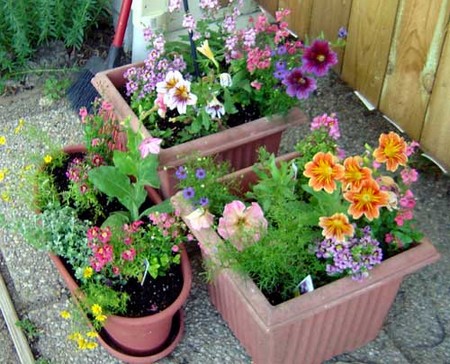In a town garden you may be restricted to growing in containers, and in any garden these can add interest to the hard-paved areas, provide height and structure, and enable you to grow plants against the house walls. Except for large, permanently sited containers they also have extra benefits—you can move them round, turn them to take advantage of the sun, and take them in under cover in the winter.
There is a huge range of containers available, from conventional pots to elaborate ceramic planters, wooden tubs, old troughs and chimney pots, or anything that will contain earth.
They depend on you
Plants in containers—even more so than those in a polytunnel or greenhouse—are completely dependent on you. They are confined to the soil you provide and reliant on you for moisture. It is not just a question of watering them regularly even if they are outside and being rained on they will still need a regular check.
Correct drainage is critical. Plants die from overwatering as much as from underwatering. Whatever the container, you must create drainage holes if they don’t already exist, and put in a layer of gravel at the base. The potting compost should also include sand to ensure it is free-draining.
The potting compost has got to provide the plant with its nutrients for life, with the possible addition of some liquid feeding or a mulch. The potting mixture recommended in the vegetable garden, would be suitable for most plants but for the vegetable fruits an extra bucket of manure could be added to the recipe.
The care and management of plants in containers is very similar to those grown under cover. It is important to check regularly for any signs of pest and disease attack, to practise good hygiene—for example, clearing dead leaves off the surface of the pot—and to give plants space between the pots. If you are replacing a plant in a pot then replace all or part of the soil, depending on the size of the pot and the size and condition of the original plant.
Fruitful plantings
Container growing is very suitable for herbs and, of course, flowers but larger containers can also be used for fruit. The largest tubs can even hold a fruit tree, as long as it is on a dwarf rootstock, and bush fruit would also be suitable. For strawberry towers or barrels, ensure that water gets to all the layers of plants.
You could also grow a range of vegetables in addition to the usual tomatoes, aubergines and peppers. A bucket-sized tub could hold cut-and-come-again salads, or could be thinly sprinkled with carrot seed. A larger tub with a wigwam-type support in it could hold climbing beans or peas. Beetroot, spinach, radishes, nasturtiums and rocket for salads or oriental greens could all flourish in tubs and their cropping season could be extended by carrying the tubs indoors at the end of the season.
Once you are confident about the gardening basics the only limit to your gardening is your imagination! Plants can be trained up the side of and over structures and sheds, potted up in all sorts of containers at all levels, and mixed together in beautiful combinations. For example, white-flowered runner beans can be mingled with deep lilac clematis on a climbing frame, or flowerbeds can be edged with green or red frilly cut-and-come-again lettuces. Hanging baskets can be filled with tiny tomatoes and deep blue lobelia, or strawberries can combine with a red trailing nasturtium. Colourful kale and cabbages, or the splendid yellow flowers and extravagant leaves of courgettes, provide structure in a border. Mounds of golden marjoram with purple alliums coming up through them in the spring, or the startling scarlet and yellow stems of Bright Lights Swiss chard in a bed of foliage plants, will break down the barriers in a garden.
Further Readings:
